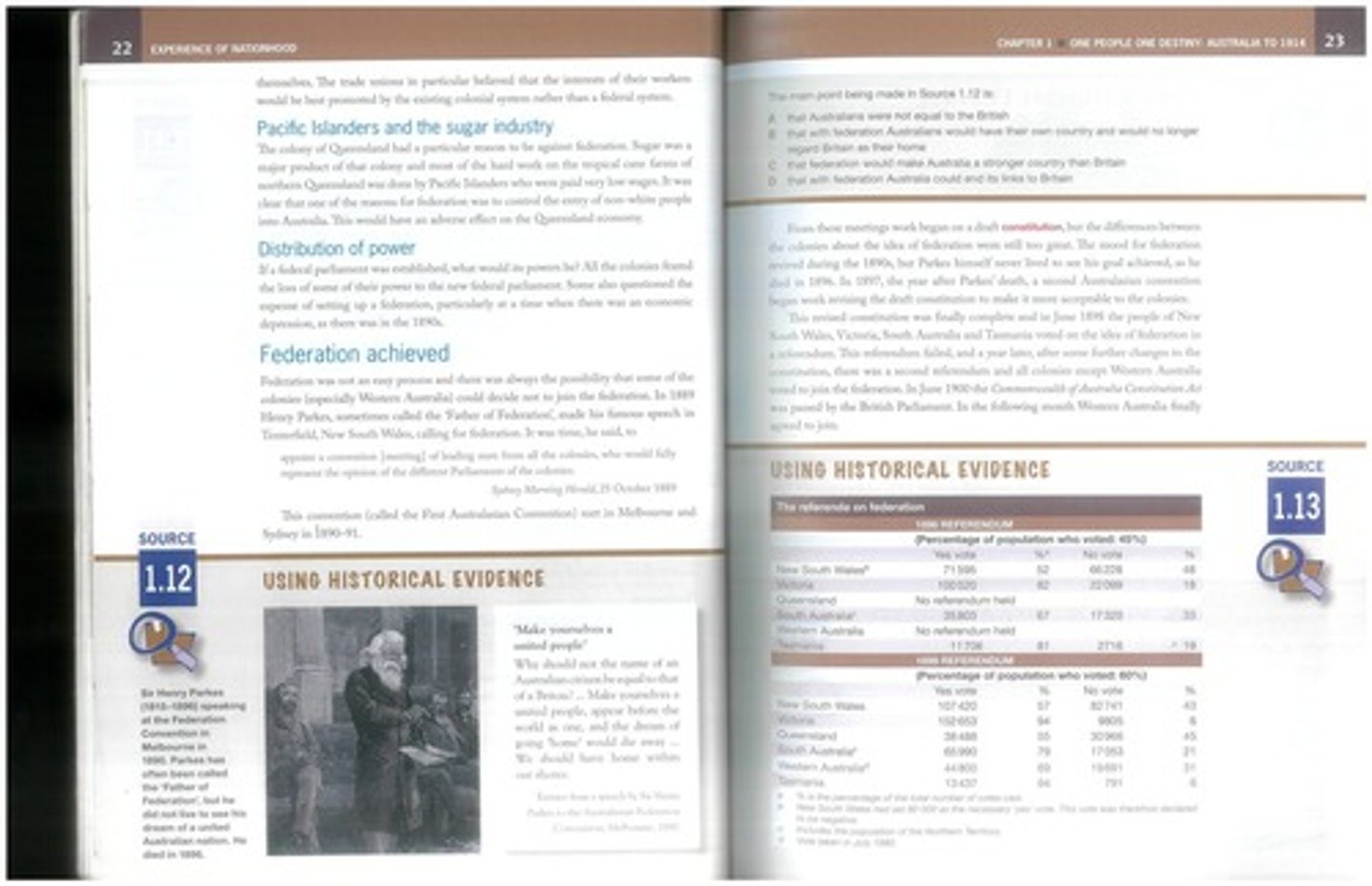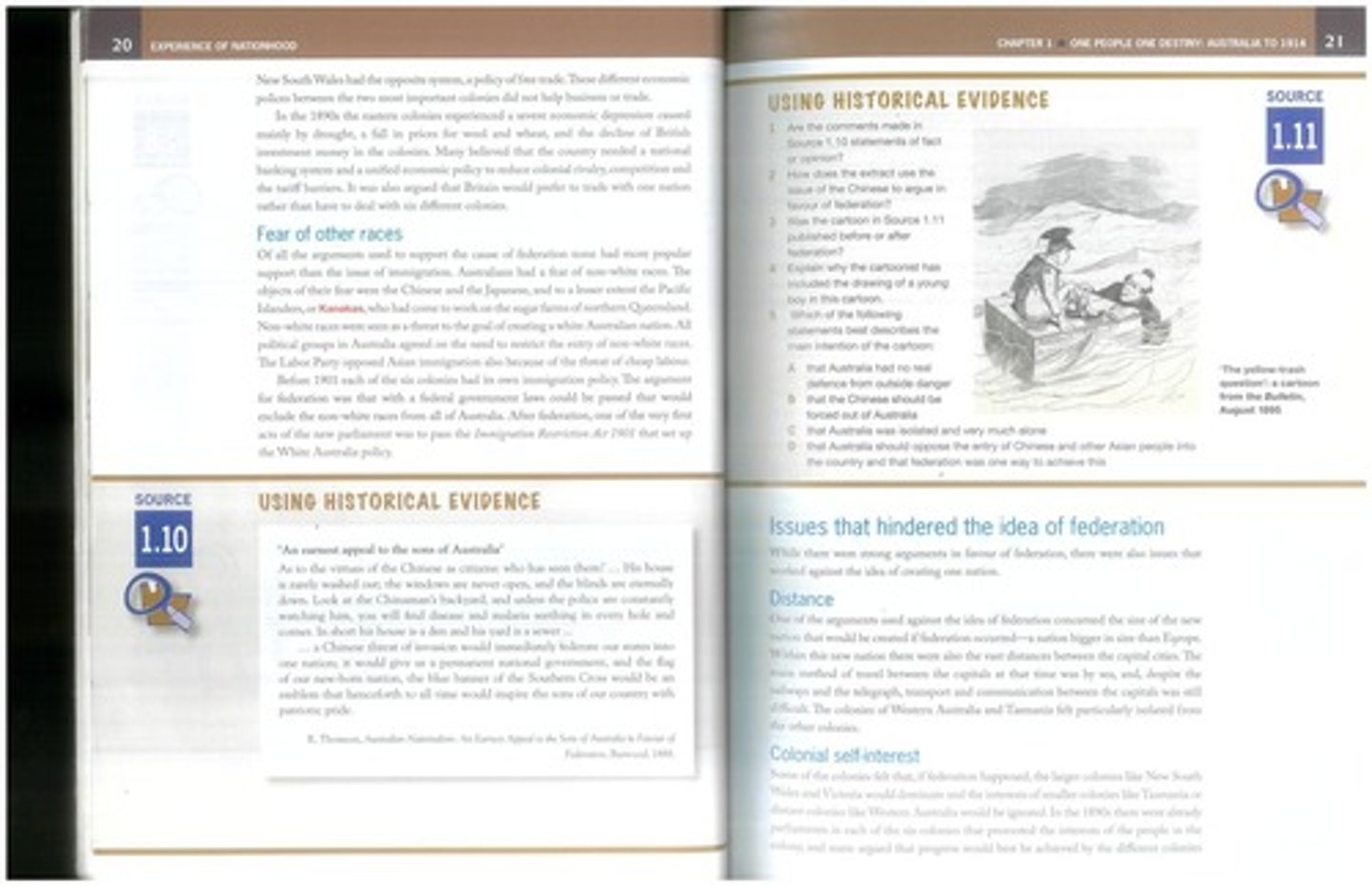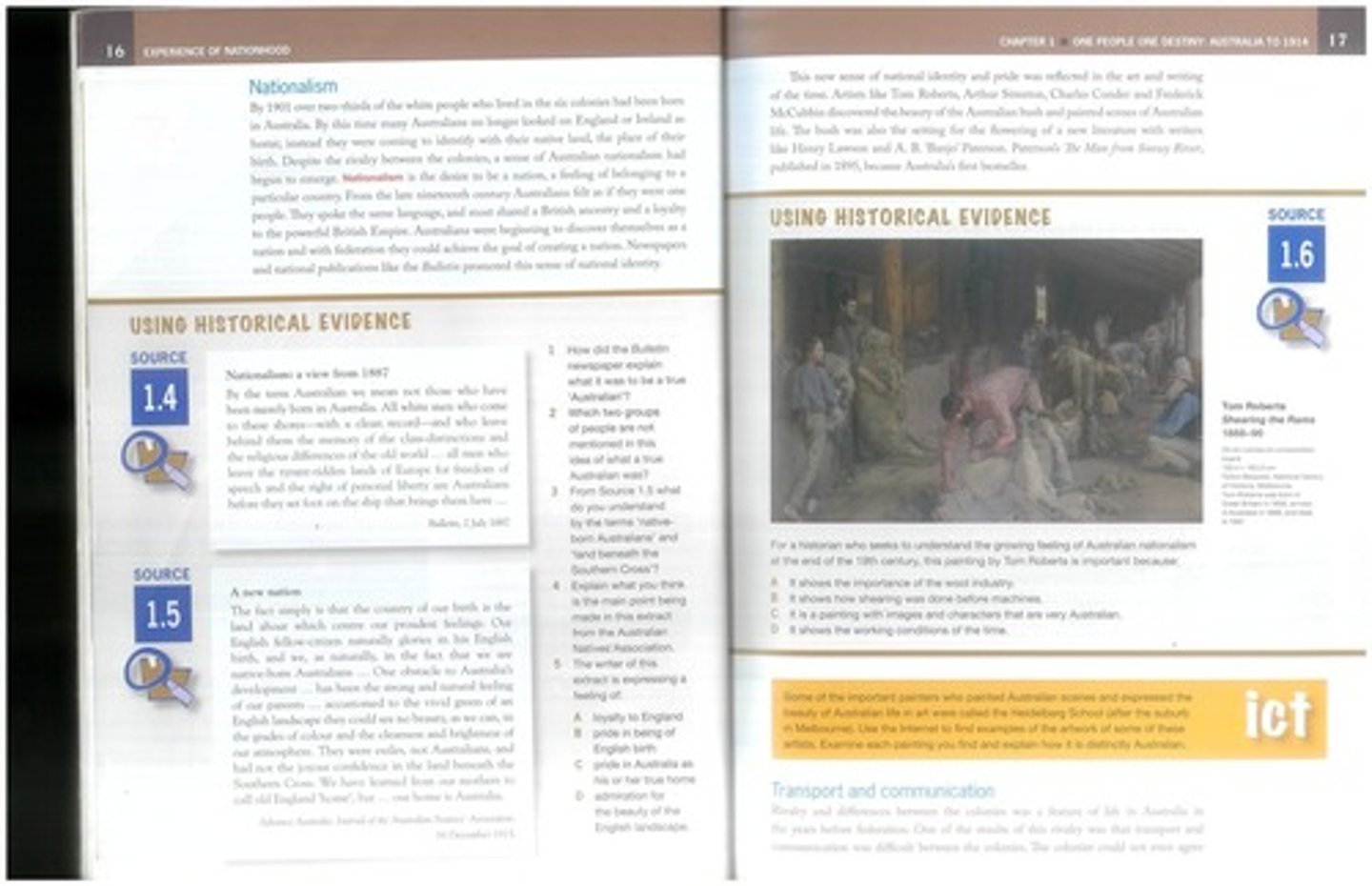Federation of Australia: Path to Nationhood by 1901
1/163
There's no tags or description
Looks like no tags are added yet.
Name | Mastery | Learn | Test | Matching | Spaced |
|---|
No study sessions yet.
164 Terms
Federation
Creation of Commonwealth of Australia on 1 January 1901.
Commonwealth of Australia
Federal government formed from six colonies.

Self-governing colonies
Independent colonies within the British Empire pre-1901.

Sir Henry Parkes
Premier advocating for Australian federation in 1889.

Nationalism
Desire for a unified national identity among Australians.

Colonial rivalry
Conflicts and differences among the six colonies.
Australian identity
Emerging sense of belonging to Australia by 1901.
Federal government powers
Authority over defense, trade, immigration, and foreign affairs.
State governments
Local governments maintaining laws post-federation.
Tenterfield speech
Parkes' call for unification of colonies in 1889.
Birthplace identity
Two-thirds of colonists born in Australia by 1901.
British Empire loyalty
Shared allegiance to Britain among Australian colonists.
Newspapers' role
Promoted nationalism and Australian identity through publications.
Cultural unity
Common language and ancestry among Australian colonists.
Colonial governance
Each colony had its own laws pre-federation.
Historical context
Federation occurred without war or revolution.
Emergence of nationhood
Australians began identifying as one people by 1901.
Immigration impact
New arrivals contributed to the national identity.
Class distinctions
Old world differences contrasted with Australian ideals.
Freedom of speech
Core value attracting immigrants to Australia.
National publications
Bulletin helped shape Australian national consciousness.
Obstacles to development
Parental influences hindered Australian identity formation.
Civic pride
Native-born Australians felt pride in their birthplace.
Democratic vote
Federation achieved through popular agreement among colonies.
Southern Cross
Constellation symbolizing Australian identity and pride.
Native-born Australians
Individuals born in Australia, distinct from immigrants.
Heidelberg School
Group of artists capturing Australian landscapes and life.
Tom Roberts
Notable Australian painter known for bush scenes.
A.B. 'Banjo' Paterson
Famous Australian poet and author of 'The Man from Snowy River'.
Henry Lawson
Prominent Australian writer known for bush poetry.
The Man from Snowy River
First Australian bestseller published in 1895.
Australian nationalism
Growing pride and identity among Australians in the 19th century.
Artistic expression
Reflection of national pride through painting and literature.
Transport difficulties
Challenges in travel between Australian colonies pre-federation.
Rail gauge
Width of railway tracks varying between Australian colonies.
Custom House regulations
Laws governing inspection of luggage during travel.
Colonial rivalry
Competition and differences among Australian colonies before federation.
Federation
Unification of Australian colonies into one nation.
Express train
Fast train service connecting major Australian cities.
Cultural identity
Sense of belonging to a specific culture or nation.
Exiles
Individuals living away from their native country.
Loyalty to England
Emotional connection to England among early Australians.
Pride in Australia
Affirmation of Australia as true home for many.
Art and literature
Mediums showcasing Australian landscapes and experiences.
Customs checks
Inspections at borders, similar to international travel.
Vivid green landscapes
Description of English scenery contrasting with Australian bush.
Australian bush
Unique natural environment central to Australian identity.
Journal of the Australian Natives' Association
Publication reflecting Australian sentiments and identity.
Indignant
Feeling or showing anger due to perceived injustice.
Possessions Search
Inspection of belongings during border crossing.
Argus Letter Audience
Intended for Victorians, Argus newspaper, and government.
Defence Argument
Federation proposed to unify Australia's military forces.
Major General J. B. Edwards
Reported on Australia's defence state in 1889.
Colonial Defence Units
Separate military forces for each Australian colony.
Wastage Criticism
Inefficiency in separate colonial defence forces highlighted.
Henry Parkes
Advocate for federation and stronger national defence.
Combined Defence Capacity
Federation aimed to create a unified military force.
Break of Gauge
Incompatibility of railway systems hindering troop movement.
Baby Armies
Term for separate colonial military forces in Australia.
Economic Protectionism
Tariffs imposed by Victoria to protect local goods.
Free Trade Policy
New South Wales' approach to eliminate trade barriers.
Economic Depression Causes
Drought, low wool prices, and reduced British investment.
National Banking System
Proposed solution for unified economic management.
Unified Economic Policy
Aim to reduce rivalry and tariff barriers.
Colonial Rivalry
Competition among colonies affecting trade and economy.
Trade with Britain
Preference for dealing with a single nation.
Victorian Artillery
Historical military unit before Australian Federation.
Mutual Defence
Cooperation among colonies for collective security.
Colonial Government
Administrative authority in each Australian colony.
Defence Report Recommendations
Advocated for federation to enhance military efficiency.
Economic Growth Levels
Variations in development across Australian colonies.
White Australia Policy
Legislation to restrict non-white immigration.
Immigration Restriction Act 1901
First law passed post-federation to limit immigration.
Fear of Non-White Races
Concerns about Chinese and Japanese immigrants.
Kanakas
Pacific Islanders working in Australian sugar farms.
Political Consensus
Agreement among parties to restrict non-white entry.
Labor Party Opposition
Concern over cheap labor from Asian immigrants.
Colonial Immigration Policies
Different rules before federation for each colony.
Federation Argument
Federal government could unify immigration laws.
R. Thomson's Appeal
Promoted federation using fear of Chinese invasion.
Distance Issues
Geographical challenges hindered federation support.
Isolation of Colonies
Western Australia and Tasmania felt particularly distant.
Colonial Self-Interest
Smaller colonies feared domination by larger ones.
Transport Difficulties
Sea travel limited communication between capitals.
Patriotic Pride
National identity symbolized by Southern Cross flag.
Chinese Threat Narrative
Used to rally support for national unity.
Cultural Perceptions
Negative views of Chinese living conditions.
Cartoonist's Intent
Critique of Chinese immigration and isolation.
Historical Evidence
Sources used to analyze federation arguments.
National Government
Proposed unified government post-federation.
Federation Convention 1890
Meeting to discuss the unification of Australia.
Economic Concerns
Fear of economic impact from non-white labor.
Public Sentiment
Widespread fear influenced immigration policies.
Cultural Homogeneity
Desire for a predominantly white Australian society.
Henry Parkes
Known as the 'Father of Federation'.
Father of Federation
Title given to Henry Parkes for his advocacy.
1896
Year Henry Parkes died before federation completion.
Queensland's Opposition
Concern over sugar industry and Pacific Islanders.
Pacific Islanders
Labor force in Queensland's sugar industry.
Colonial System
Existing governance structure opposed by trade unions.